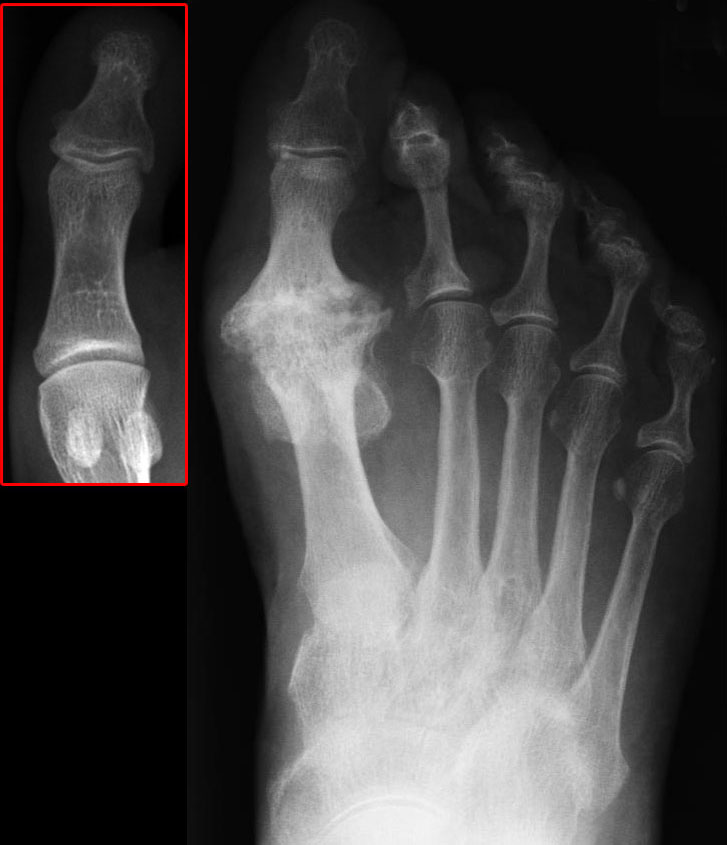Osteoarthritis of the First MTP Joint
In order to understand this condition it is important to understand the anatomy and function of the foot. Please read Foot Pain Info ‘s section on basic foot anatomy. For additional background information on the biomechanics of the foot please read Foot Pain Info ‘s section on basic foot and ankle biomechanics.

What is osteoarthritis?
The word arthritis means inflammation (swelling) of a joint. Osteoarthritis, also called “wear and tear” arthritis is the most common type of arthritis. It is estimated that osteoarthritis affects one out of every ten Canadians and that 85% of Canadians over the age of 70 will have osteoarthritis in at least one of their joints.
What is hallux rigidus?
The foot has 26 bones in it. There are a number of small joints between these bones. Osteoarthritis can affect the articular cartilage of any or all of these small joints. Hallux rigidus is the term used to describe osteoarthritis of the first MTP joint of the foot. Articular cartilage is the smooth coating that covers the surface of the bones inside the small joints of the foot. Articular cartilage also cushions and helps lubricate the joint surfaces. In osteoarthritis the articular cartilage begins to degrade. Over time the articular cartilage can thin or form cracks. Tiny pieces of cartilage may come loose and float inside the first MTP of the foot, further irritating the joint. After a long period of time the cartilage can become completely “worn away” and the bones can begin to rub together.
What does hallux rigidus feel like?
Osteoarthritis of the first MTP joint usually comes on slowly and results in pain, stiffness and/or swelling of the joint. Bumps or nodes may appear around the MTP joint. When the joint is moved a grating sound may be heard. Sometimes the first MTP joint can have a mild amount of osteoarthritis and feel perfectly fine.
How is hallux rigidus detected?
Most types of treatment for hallux rigidus work best when started early, before there is a lot of “wear and tear”. For this reason establishing a correct diagnosis is very important. In some cases hallux rigidus can be diagnosed based on the medical history and physical examination of the MTP joint. An x-ray may be ordered to determine how much joint damage there is. X-rays may reveal narrowing of the space between the bones of the MTP joint or bone spurs (osteophytes). Sometimes blood tests or joint fluid tests are ordered to confirm the diagnosis or to distinguish between different types of arthritis. Other tests like bone scans or MRI’s are not usually required.
What causes hallux rigidus?
No one knows for sure what causes osteoarthritis to develop in the first MTP joint of the foot but some risk factors include:
- Previous first MTP joint injury or fracture
- Family history of osteoarthritis
- Being overweight
- Damage to the first MTP joint of the foot from another type of arthritis such as rheumatoid arthritis or gout
- Increasing age
What is the treatment for hallux rigidus?
The treatment of hallux rigidus should be individualized. Proper footwear is very important. Low heeled shoes with a large toe area and rigid insole are recommended. Other treatment options include exercises to improve range of motion and strength, medications to relieve pain and swelling, education on activity modification, weight loss if required, heat/cold therapy, shoe orthotics, injections and in some cases surgery.
Is there a cure for osteoarthritis?
A lot can be done to help people who have osteoarthritis. The goal of treatment is to reduce pain, control swelling and maintain or improve mobility of the affected joint but unfortunately there is no known cure for osteoarthritis.
What other information is available on hallux rigidus?
Foot Pain Info ‘s links section has additional information on this topic. Links have been provided to other websites as well as online medical journals. Visit Joint Pain Info for information on other joint injuries and problems.
